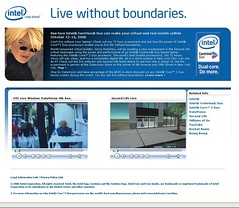[youtube=http://www.youtube.com/v/WB5EFp7NbP0]
Versu will be building, sleeping and living SL for 72 hours straight during this demonstration of the Intel Core 2 Duo processors from a live window on 5th Avenue in New York City. Check out the live feed HERE.
Why cover this event here? Because she has decided to recreate the architecture, context and streetscape of her physical surroundings within the NYC storefront. This establishes a truly compelling synchronicity between SL and RL, since the bystanders watching her from the RL storefront can recognize the virtual replica, and can see the SL bystanders, and vice versa. On a number of occasions, they were interacting with each other, smiling, waving, and blowing kisses.
By watching the two simulcasting live feeds from both RL and SL, you could plainly see the differences between these two states of ‘reality’. On the one hand, I overheard lots of buzz amongst SL residents wishing they could be in New York City to see the physical installation in person. Some even talked about taking a day trip tomorrow to see it for themselves. However, many of the RL spectators seemed to be staring in awe at the uniqueness of total freedom in the virtual world. After all, the virtual spectators could fly around and soar to the top of the building, whereas the RL visitors had gravity to deal with. The virtual guests also seemed to be having quite a bit more fun, as the streetscape errupted into uninhibited dancing and celebration as the virtual sun set last night. People from around the world were able to stand beside Versu, and cheer her on.
Although unverified, it seems as though the RL Versu was moving her setup around the storefront throughout the morning, in an attempt to avoid the direct uncontrolled sunlight entering the space; an interesting counterpoint to her virtual location, which remained unchanged, save the occasional escape needed to reach the outer limits of her build.
In all, this installation really made me think. How could real time synchronicity between real and virtual be useful from an architectural standpoint? Since architects must operate seamlessly between the virtual worlds of design visualization, while remaining firmly planted in reality, surely there are ways in which a real time portal between these worlds would be useful.
